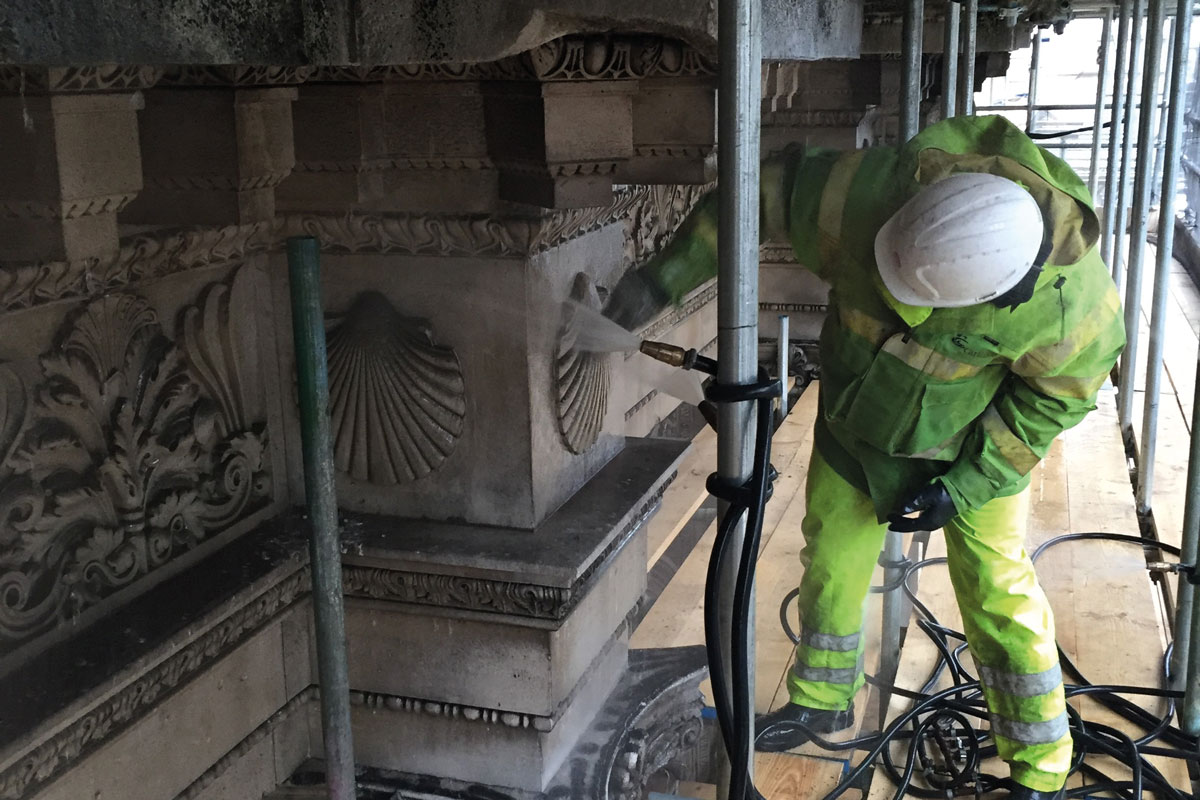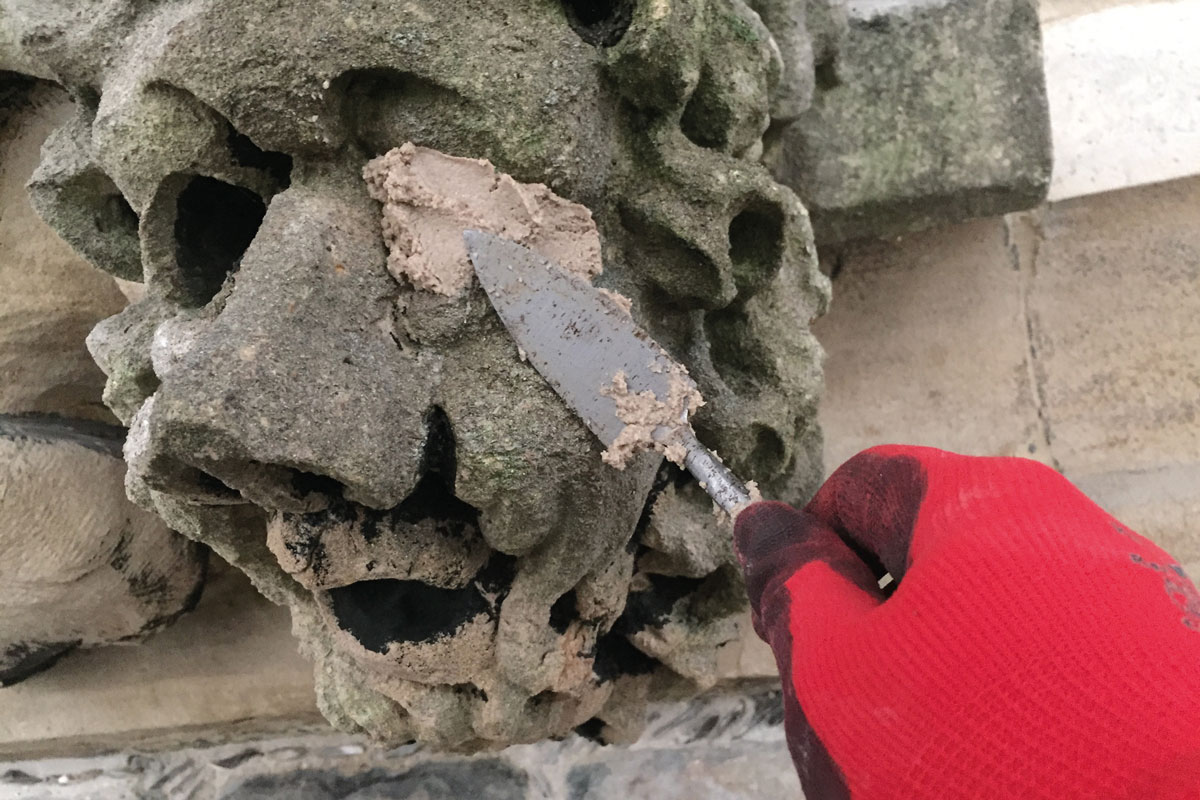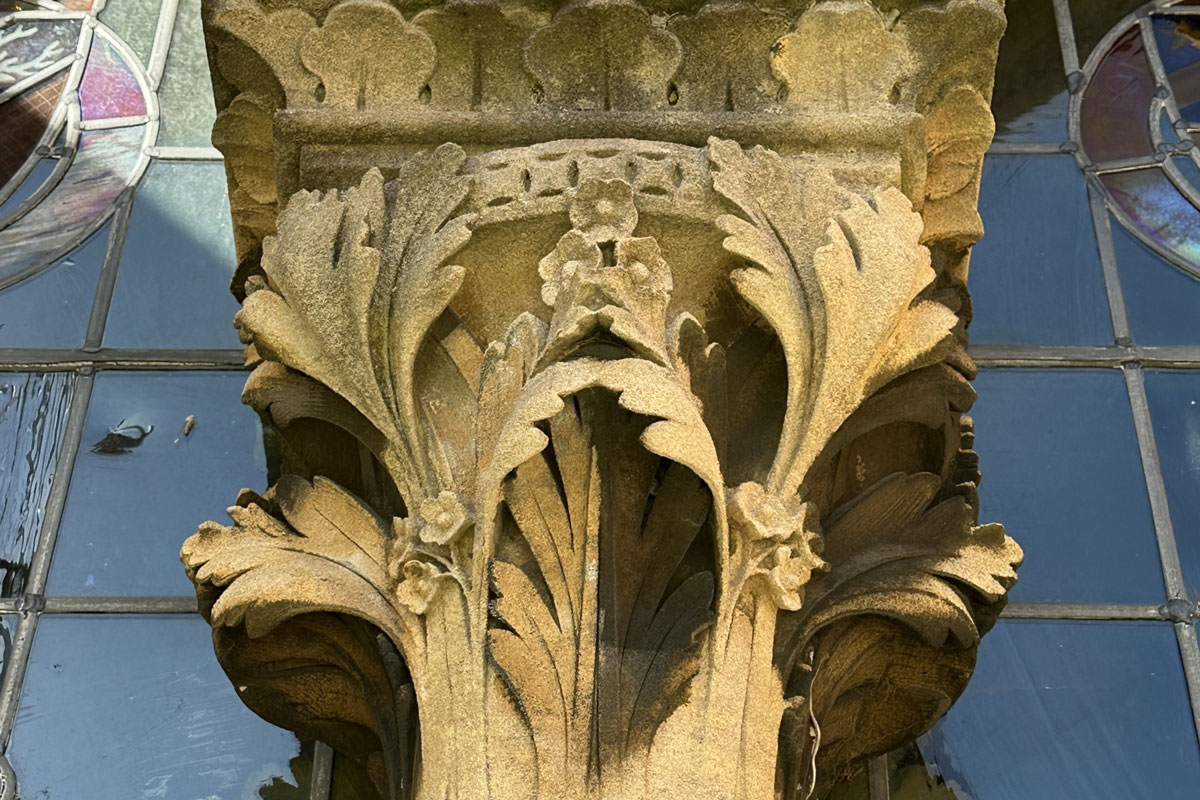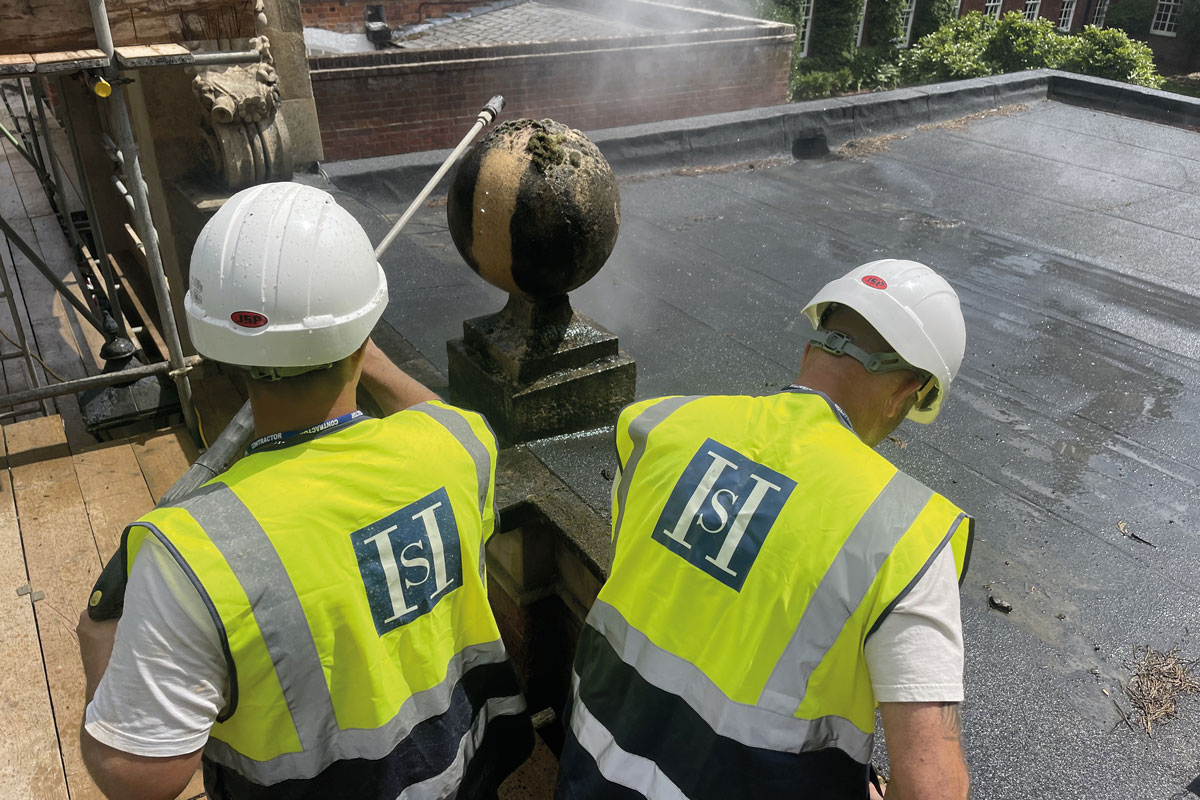Spencer Hall of Spencer Hall Historic Building Conservation discusses the benefits and considerations of cleaning stone
Stone cleaning is an important process when undertaking conservation work and is a key tool in the conservators’ armoury in both preventative conservation and building maintenance. Cleaning doesn’t simply help to improve overall appearances, but more importantly, can help remove potentially harmful atmospheric pollutants, which can damage stonework irreversibly. Cleaning can also help to expose further existing/potential damage and identify masonry requiring repair or replacement, as biological growth can be disguising and will harbour moisture, which in turn can lead to accelerated decay.
Consideration should however always be given to the level of clean that is to be achieved. It is important that we do not over clean and strip stone of all its chronology, and so a judicious approach should always be undertaken. This can be difficult to define sometimes, as the ‘correct’ level can be somewhat subjective. As always, good communication is the key to understanding client/stakeholder expectation and the context and significance of the work understood, as these will help define what is best for the individual object, whether building, sculpture or monument.
Cleaning trials are always advocated in advance to establish the level of clean that is both achievable and the most appropriate.
Doff
The Doff is perhaps the most commonly used brand name for building conservation specific superheated pressure washers. It was the first system to be widely used and so much like use of the word ‘Hoover’ has become synonymous with conservation steam cleaning. It is by no means the only brand however and other manufacturers (such as Thermatech and Torick) have since emerged in the market and have fine-tuned alternative systems. They are NOT pressure washers as one might use on say, a patio etc. The advantages of the Doff as a piece of technical machinery, is that both pressure and temperature are fully controllable – allowing the use of cold water at minimal pressure to be used all the way up to a constant steam temperature of 150 degrees at pressures of up to 90 bar, giving a wide range of flexibility.
Jos
Like the Doff, Jos (pronounced ‘Yoss’), Vortech and Torc are variants of the same machine and work by very different principle to the Doff. The Jos has been a cleaning tool for 30+ years in conservation cleaning and was developed by German engineers. Vortech is an English alternative, but works in a similar manner. They all operate on the principle of water under pressure being applied through a nozzle to the face of masonry in a vortex. This swirling vortex sweeps across the surface and very gently washes/abrades the surface. A range of aggregates can be added to this vortex to increase the effectiveness of the clean. These aggregates are rated on the Mohs scale (which measures hardness) – a ‘hard’ material being something like corundum powder (9 Mohs) through to a ‘soft’ material like talcum powder (1 Mohs). The Mohs scale is a purely ordinal scale and as such, corundum (9) is twice as hard as topaz (8), but diamond (10) is four times as hard as corundum. The ‘normal’ material used however is Calcite powder, which is rated 3 on the Mohs scale. As with all methods here, care must still be taken not to over-clean and potentially damage the masonry and this is very much down to the condition of the substrate, the choice of aggregate used and most importantly, the skill of the operator.

Nebulus cleaning conducted at the Royal Academy
Nebulus cleaning
Nebulus water cleaning is perhaps the most natural and subtle method of cleaning, as the process replicates rainwater running over the surface of the building which gradually rinses away surface dirt. The method by which this is completed relies on a set of nozzles being set up across a proportion of the façade (working from top down) and leaving them to run continuously for a period (which can be anything from 10 minutes to several days, depending on level of soiling). The surface is then lightly scrubbed, and this agitating action removes the saturated accretions. Whilst this can be very effective as a good overall clean, it does rely on significant amount of water use and does not target problem areas, meaning that it will often be used in conjunction with one of the other methods listed.
Micro air-abrasion
Not unlike the Jos, micro air-abrasion systems work by forcing air through a compression chamber into which abrasive particles are placed. The air carries said aggregates down the hose and out via a nozzle onto the area in question. Type of aggregate, pressure and the quantity of abrasive used are the three main factors which control the effectiveness of this equipment. Unlike the Jos however, no water is utilised. This is often used to greatest effect on small delicate sculpture in a studio environment, although larger scale equipment is available on the market for building façades. In the wrong hands, this could be as damaging as sandblasting and so only a practitioner who understands the fundamentals of its use should be tasked with its deployment.
Chemical cleaning
Cleaning with chemicals is a wide field that can incorporate everything from mild detergents through to strong acids and alkalis. Acid and alkali cleaning has fallen out of favour in recent years and for good reason. High strength acids will react adversely with Calcium Carbonate (CaCO3 - limestone) and also have the potential to damage both brickwork and some sandstones. Strong alkaline solutions can conversely be linked to the formation of salts on both stone and brick. In my opinion, the use of either on natural stone is probably best avoided. The cleaning of granite, brickwork and terracotta may sometimes be appropriate, but great care and consideration will need to be imposed and a suitable number of trials completed to establish the best approach. As with all aspects of cleaning, low strength percentages should be employed first and increased only if deemed absolutely necessary. Ammonium carbonate is a mild alkaline cleaner and is often used held in a clay medium (the process of which is described in greater detail below) to soften black encrusted clinker. It works by reacting with Calcium Sulphate (CaSO4) on the blackened surface and forms both Calcium Carbonate and soluble Ammonium Sulphate (NH4)2SO4 which can be rinsed away easily with the addition of water (H20) and light scrubbing.

Ammonium carbonate poultice used at Windsor Castle
Poultice cleaning
Both ‘clean’ water and chemical poultices can be used to good effect in cleaning and lifting staining. Poultices work by drawing out the stain using capillary action. The most common poultice medium used is Sepiolite (a clay powder), although paper pulp is often added at 50:50 to produce a highly absorbent and malleable mixture that doesn’t dry out too quickly. Sepiolite is a relatively inert Magnesium Silicate and is often favoured as a medium in poulticing by conservators on stone sculpture. Another type of poultice popular in conservation cleaning to stonework is EDTA (Ethylene Diamine Tetra-acetic Acid), a chelating agent which breaks down organic binders. The common form of this poultice is where the product is bound in a naturally produced latex (commonly containing small amounts of ammonia). The ammonia acts as a useful cleaning agent in its own right and triggers the curing of the rubber once exposed to air. This cured latex film can then be easily removed by hand, without the use of water and as both surface based dust and imbued dirt lifts with it, this removal results in a cleaned surface (often just needing a damp wipe down following). This method was used to great effect to the interior of St Paul’s Cathedral during the major restoration in the early 2000s and is still applicable today.

An example of laser cleaning trialled to friable decorative stonework
Laser cleaning
The word L.A.S.E.R. is an acronym for Light Amplification by Stimulated Emission of Radiation.
Laser can be used to clean carbonation/sulphation from a variety of substrates (limestone, sandstone, marble, terracotta etc) in a very controlled manner. Traditionally it has been most suited to working on delicate material in a workshop environment, but advances in technology have seen this now crossover into its successful use on site. There are still however limitations, due to scale of operation and in turn cost, but this is getting far more commercially viable year on year. Safety issues are of course paramount. Laser can damage retinas from a considerable distance away, so light shielding around the working area is essential. All adjacent areas MUST also be well signed to avoid people unexpectedly chancing across it in use. Goggles must be worn and these are specific to the wave length of laser being used and so guidance must be sought. Trials should of course always be encouraged to establish suitability and results are often influenced by nature of substrate, the level of soiling and other environmental factors. The control offered by laser cleaning enables the conservator to remove unwanted layers without over-cleaning the valuable surface of the stone, meaning patina, fine surface detail, tool markings and important surface coatings can be preserved. Laser systems provide the conservator with an extremely gentle method of cleaning from very fragile surfaces without any direct physical contact.
Further to stone cleaning it is often necessary to reassess condition. If losses to joint material have occurred or friable material is removed, these areas should be reassessed before reinstatement.
To recap, when considering cleaning stone it is important to try and achieve a consistent finish that meets expectation but does not strip the object fully of its integrity. A balance should ideally be sought between removal of dirt and detritus and retention of some of the accumulated patina which is in keeping with the age of a piece. Over-cleaning will often be viewed as ‘damage’ by many in the conservation world and so trials should be completed in advance to an area where they can be evaluated without detrimental impact on the overall finish.
Spencer Hall ACR IHBC MCIOB
Spencer benefits from 30 years’ experience working in the heritage industry during which time he has worked for many of the country's leading conservation companies. He has been involved with some of the highest profile schemes across the UK, working on buildings of national and international importance. In the 90s, he completed his post graduate studies in conservation and is now an ICON-accredited Conservator-Restorer, a Full Member of the IHBC and a Chartered Construction Manager (MCIOB). In 2020 he formed Spencer Hall Historic Building Conservation (SHHBC Ltd) which provides a pragmatic approach to the conservation and restoration of a wide range of historic building types and materials. The company provides solutions in line with the highest conservation standards. SHHBC is regularly commissioned on a portfolio of projects across both private and public sectors by property owners, surveyors, specialist contractors, conservation architects and trusts/organisations.

